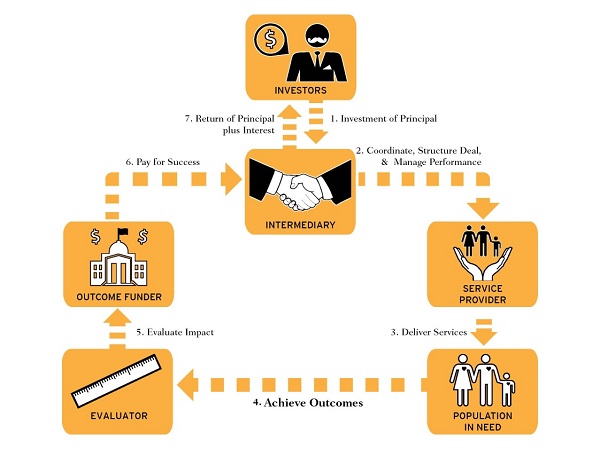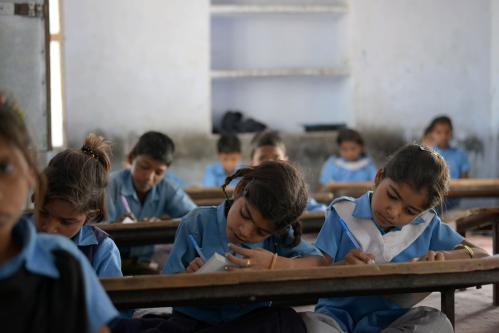Public and private sector leaders currently face the daunting task of identifying the path to achieving the United Nation’s 17 Sustainable Development Goals (SDGs or Global Goals) within 14 years. Financing is arguably one of the most important pieces of this complex puzzle. In the last 15 years, a number of innovative financing mechanisms, which address the volume of finance, the effectiveness, or both, have been designed and implemented. Results-based financing (RBF) arrangements, in which governments or donors pay service providers contingent on outputs or outcomes, are one of the fastest growing types of innovative financing.
Social impact bonds (SIBs) and related development impact bonds (DIBs) combine RBF and impact investing (investing that seeks both a social and a financial return). In an impact bond, an outcome funder (a government in the case of SIBs and a third party such as a donor agency or foundation in the case of DIBs) repays private investors with a return contingent upon the achievement of agreed upon outcomes (see Figure 1). Since the first one was established in 2010, 62 SIBs have been implemented across 14 high-income countries seeking to achieve a multitude of social outcomes. To date, there are two DIBs contracted in middle-income countries: one focusing on girls’ education in Rajasthan, India and the other to improve agricultural productivity in the Amazon rainforest of Peru. In addition to these contracted impact bonds, there are at least 60 initiatives in high-income countries and about 30 in low- and middle-income countries that are in feasibility or design stages.
Figure 1: Basic impact bond mechanics

Impact bonds, and other RBF mechanisms, require the measurement of outcomes and create an incentive for the service provider to deliver results. Both aspects encourage the service provider to improve performance management and, ultimately, the quality of the service. Because governments or donors only pay if results are achieved, funding is not wasted on unsuccessful programs. Furthermore, the guarantee of value can encourage governments or donors to explore new, potentially high-impact interventions, instead of continuing to fund low-impact programs.
Impact bonds may also have other positive spillover effects on development. For example, the involvement of private intermediaries and investors may also help grease the wheels of new government contracting systems or provide a way for the business sector to engage in a social issue.
However, despite the enormous potential of impact bonds, there are also some considerable limitations and challenges associated with their implementation. Three criteria are necessary to even consider the use of an impact bond:
- The ability of the funder to pay for outcomes rather than inputs
- Sufficient evidence that a given intervention and service provider will be able to deliver a stated outcome for an investor to take the risk of engaging
- Meaningful outcomes (i.e., related to the SDG indicators) that can be measured within a time frame suitable to both investors and outcome funders
In addition to these three critical criteria, the ability for the key stakeholders to collaborate with one another has enormous implications for getting an impact bond off the ground. These factors contribute to the complexity and high transaction costs associated with impact bonds (relative to traditional input-based financing). Given these constraints, impact bonds are suited to areas where service providers need flexibility and where risk factors discourage direct funding but are minor enough to attract impact investors.
Thus far, these criteria have limited impact bonds to particular subsectors, regions, and investor types and have restricted their scale (both monetarily and in terms of beneficiary numbers). Impact bonds have been developed in fields with complex service inputs and simple outcomes, and for services that cater to particularly underserved or marginalized populations. The scale of impact bonds has been limited—the majority serve fewer than 2,000 individuals, and the largest reaches less than 16,000. Investors have been limited to philanthropic or impact investors rather than commercial investors. However, all impact bonds thus far have supported interventions that have at least some evidence of effectiveness.
Given trends in the global impact bond market, what role do impact bonds have in fulfilling the financing needs to achieving the SDGs, in particular in developing countries?
Impact bonds are likely to be improve effectiveness of financing rather than increasing volume. They also serve an important role in financing mid-scale interventions with some evidence of effectiveness. While they may not be best suited to large-scale financing of social services, they have the potential to affect large-scale systemic shifts in how governments and service providers think about service provision because they build cultures of monitoring and evaluation, encourage investments in prevention, and incentivize collaboration, all of which are essential to achieving the SDGs.






Commentary
What role do impact bonds have in the achievement of the Global Goals?
July 13, 2016